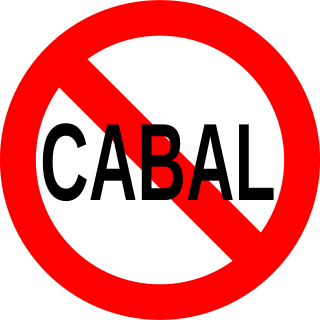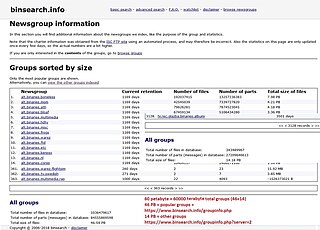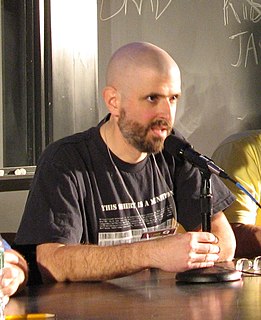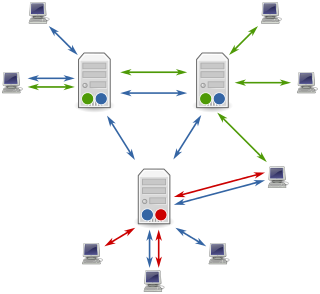Related Research Articles
The backbone cabal was an informal organization of large-site news server administrators of the worldwide distributed newsgroup-based discussion system Usenet. It existed from about 1983 at least into the 2000s.
A frequently asked questions (FAQ) forum is often used in articles, websites, email lists, and online forums where common questions tend to recur, for example through posts or queries by new users related to common knowledge gaps. The purpose of an FAQ is generally to provide information on frequent questions or concerns; however, the format is a useful means of organizing information, and text consisting of questions and their answers may thus be called an FAQ regardless of whether the questions are actually frequently asked.

James Parry, commonly known by his nickname and username Kibo, is a Usenetter known for his sense of humor, various surrealist net pranks, an absurdly long signature, and a machine-assisted knack for "kibozing": joining any thread in which "kibo" was mentioned. His exploits have earned him a multitude of enthusiasts, who celebrate him as the head deity of the parody religion "Kibology", centered on the humor newsgroup alt.religion.kibology.
A Usenet newsgroup is a repository usually within the Usenet system, for messages posted from users in different locations using Internet. They are discussion groups and are not devoted to publishing news. Newsgroups are technically distinct from, but functionally similar to, discussion forums on the World Wide Web. Newsreader software is used to read the content of newsgroups.

There Is No Cabal is a catchphrase and running joke found on Usenet. The journalist Wendy M. Grossman writes that its appearance on the alt.usenet.cabal FAQ reflects conspiracy accusations as old as the Internet itself. The anthropologist Gabriella Coleman writes that the joke reveals "discomfort over the potential for corruption by meritocratic leaders".
alt.sex.stories is a Usenet newsgroup for erotic stories created on May 7, 1992, by Tim Pierce as an alternative to pre-existing alt erotica newsgroups. The group was initially unmoderated, a feature that was not shared by some of the other Usenet or altnet newsgroups. This feature allowed for greater user freedom.

The alt.* hierarchy is a major class of newsgroups in Usenet, containing all newsgroups whose name begins with "alt.", organized hierarchically. The alt.* hierarchy is not confined to newsgroups of any specific subject or type, although in practice more formally organized groups tend not to occur in alt.*. The alt.* hierarchy was created by John Gilmore and Brian Reid.

B News was a Usenet news server developed at the University of California, Berkeley by Matt Glickman and Mary Ann Horton as a replacement for A News. It was used on Unix systems from 1981 into the 1990s and is the reference implementation for the de facto Usenet standard described in RFC 850 and RFC 1036. Releases from 2.10.2 were maintained by UUNET founder Rick Adams.
alt.sex is a Usenet newsgroup – a discussion group within the Usenet network – relating to human sexual activity. It was popular in the 1990s. An October 1993 survey by Brian Reid reported an estimated worldwide readership for the alt.sex newsgroup of 3.3 million, that being 8% of the total Usenet readership, with 67% of all Usenet "nodes" carrying the group. At that time, alt.sex had an estimated traffic of 2,300 messages per month.

Mary Ann Horton, is a Usenet and Internet pioneer. Horton contributed to Berkeley UNIX (BSD), including the vi editor and terminfo database, created the first email attachment tool uuencode, and led the growth of Usenet in the 1980s.
talk.origins is a moderated Usenet discussion forum concerning the origins of life, and evolution. It remains a major venue for debate in the creation–evolution controversy, and its official purpose is to draw such debates out of the science newsgroups, such as sci.bio.evolution and sci.bio.paleontology.

Joel K. "Jay" Furr is a writer and software trainer notable as a Usenet personality in the early and mid-1990s.
alt.atheism is a Usenet newsgroup within the alt.*hierarchy that discusses atheism. The group was originally created on February 6, 1990 by a member of the alt.pagan newsgroup, to provide an alternative forum for the numerous discussions on atheism that were overwhelming the pagan group. A survey of usenet groups in 1994–1995 found that, among 70 groups discussing "consciousness, spirituality, and religion ", it was the group with the highest traffic volume. Nash (2002) writes that "atheist and freethought newsgroups" including alt.atheism have "done much to remove the sense of isolation felt by many with antireligious opinions".
Usenet II was a proposed alternative to the classic Usenet hierarchy, started in 1998. Unlike the original Usenet, it was peered only between "sound sites" and employed a system of rules to keep out spam.
The Big 8 are a group of newsgroup hierarchies established after the Great Renaming, a restructuring of Usenet that took place in 1987. These hierarchies are managed by the Big 8 Management Board. Groups are added through a process of nomination, discussion and voting.
Control messages are a special kind of Usenet post that are used to control news servers. They differ from ordinary posts by a header field named Control. The body of the field contains control name and arguments.
A Usenet personality was a particular kind of Internet celebrity, being an individual who gained a certain level of notoriety from posting on Usenet, a global network of computer users with a vast array of topics for discussion. Since its inception, Usenet newsgroups have attracted a wide variety of people posting all manner of fact, fiction, theories, opinions, and beliefs. Some Usenet posters achieved a certain amount of fame and celebrity within Usenet circles because of their unusual, non-mainstream ideas, or because their writings and responses are considered especially humorous or bizarre.
rec.music.hip-hop is an Internet Usenet newsgroup primarily dedicated to the discussion of rap and hip-hop music. RMHH is one of the longest running newsgroups on Usenet for the discussion of rap and hip-hop, established in 1995.

Usenet is a worldwide distributed discussion system available on computers. It was developed from the general-purpose Unix-to-Unix Copy (UUCP) dial-up network architecture. Tom Truscott and Jim Ellis conceived the idea in 1979, and it was established in 1980. Users read and post messages to one or more categories, known as newsgroups. Usenet resembles a bulletin board system (BBS) in many respects and is the precursor to Internet forums that became widely used. Discussions are threaded, as with web forums and BBSs, though posts are stored on the server sequentially.
References
- 1 2 "Modern Usenet Newsgroup Hierarchies History". livinginternet.com. Archived from the original on 22 July 2012. Retrieved 24 September 2012.
- ↑ "Hardy, History of the Net". Rs79.vrx.net. 28 September 1993. Archived from the original on 22 May 2011. Retrieved 31 August 2009.
- ↑ "Controlling the Virtual World". Cse.stanford.edu. Archived from the original on 27 May 2009. Retrieved 31 August 2009.
- ↑ "The Great Renaming FAQ". Linux.it. Archived from the original on 22 July 2011. Retrieved 31 August 2009.
- ↑ "So You Want to Create an Alt Newsgroup". 12 July 2008. Retrieved 27 May 2007.
- ↑ "RESULT: humanities.misc passes 508:97". 11 April 1995. Retrieved 6 February 2016.